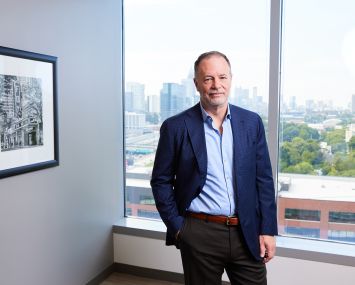We recently put the finishing touches on a stunning new Manhattan office space for a recognized worldwide leader in the recruitment industry with offices all over the world. What’s so special about that, you may wonder? Great question. What made this move-in particularly noteworthy was that every decision made—design, build and implement—happened remotely, yet it was still a smooth process.
That’s not to say it was without challenges. For instance, our primary contact for this office design project was a London-based head of real estate and she never once visited the site in person. Factoring in our client’s international schedule and heavy travel agenda, we served as her firm’s local extension, coordinating the architecture and design.
Among the day-to-day hurdles we faced was a six-hour time difference, narrowing the amount of time for communication. Presentations needed to be highly detailed so that no time was wasted, and all of them needed to be delivered via GoToMeeting and Google Hangout.
We oversaw several aspects of the project and led the team with some good old-fashioned ingenuity, careful budgeting and a healthy dose of planning. For instance, our client’s preferred furniture dealer was located in another part of the U.S. (we never had the chance to meet them in person, either!), so we needed to heavily coordinate delivery of materials for sign-off, shipping finish samples overseas and utilizing couriers to deliver products to their door, all while factoring extra time into the schedule.
Technology has made projects such as these easier to execute from afar, whether it’s in another part of the U.S., Europe or even the Far East. Teleconferencing and video chats are hardly a new thing, and it is still necessary to choreograph the design plan so that, for instance, a client can walk on top carpet choices in China or Paris. But some fresh technology has allowed for a more seamless execution.
One of the tools we used in our work with the recruitment firm was Newforma, a software that let us manage project details at the office, from the cloud and on the go. It allowed us easy Web access and connectivity with multiple parties. Best of all, the project files all lived in one place so our client could view them readily.
Another tool we found helpful was content management solution Plan Grid. We were able to work online or offline, synchronize markups and documents and build from pretty much anywhere. We were able to maintain one master set of drawings with automatic version control and keep the whole team up to date. Through Plan Grid we developed punch lists to capture photos, locations and notes from the field and created and distributed reports from our iPads.
While there may have been nearly 3,500 miles between us and our London-based client, through the use of smart technology, careful planning and personalized attention, we could not feel closer to them or their finished space. We recently met the New York team in their new space and look forward to shaking the hand of our London counterpart when she’s in the city next!
sespector@spectorgroup.com


